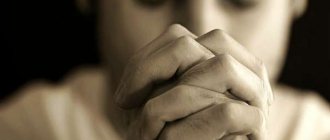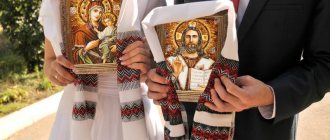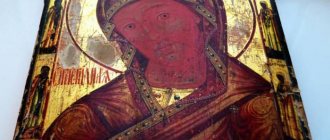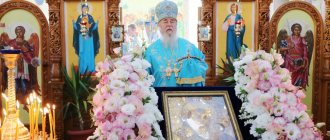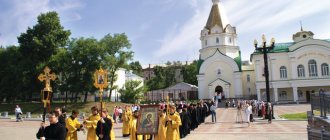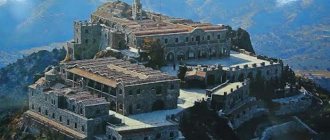According to legend, the image of the Savior not made by hands is the very first Orthodox image that immortalized the image of the Lord God. The role of this icon is very important for every Christian; quite often this shrine is put on a par with the Life-Giving Cross and the Lord’s Crucifixion. Since ancient times, Orthodox people have shown interest in the meaning of the icon of the Savior Not Made by Hands, and in what cases they turn to it for help.
Dear Brothers and Sisters, we will be very glad if you subscribe to our group on VK, there you will find even more prayers, icons and other interesting information, here is the address link - Orthodox group! Or our Orthodox group in Odnoklassniki! We are also pleased to remind you that on the pages of our church store you can find all possible Orthodox goods!
History of the icon of the Savior Not Made by Hands
The icon of Jesus has a special meaning in Orthodox iconography. This shrine has two versions of its appearance: • on a towel (Mandylion); • on the stone (Keramion).
According to the first legend, which says that one day the ruler Abgar fell ill with a dangerous illness and made a written request to Christ to save him from leprosy. Jesus Christ sent a letter to the king, but the illness did not subside.
Then the king sent his court artist with an order to make a portrait of Christ. But looking at the servant’s unsuccessful efforts, the Savior took a clean handkerchief and a bowl of water. Having rinsed his face, Christ took a towel and left his appearance on it. When the artist Abgar went back, he spent the night in the town of Hierapolis and buried a towel with the image of Jesus imprinted in stone slabs. The next morning, the face of Christ was displayed on one of the stones. When a servant gave King Abgar a miraculous towel with the image of Christ, the sick man instantly got rid of his illness.
The scarf and the Plate were soon sent to Constantinople, and a few years later these shrines were delivered to Kievan Rus. The face of the Savior on a towel is characterized by a slightly greater significance than on a stone. But divine help equally comes to believers who offer prayers in front of these shrines. Dear Friends, we remind you that on our pages you can buy an icon of Stas Not Made by Hands, as well as buy icons of the Lord and buy icons of Jesus Christ and even buy an icon of the Last Supper!
Lyrics
For believers who want to turn to the icon with requests for help in accordance with all the rules, the texts of prayers and a troparion will be presented. They can be read either by heart or on paper, in printed form.
Prayer
First prayer:
O Most Blessed Lord Jesus Christ, our God! You, from the ancient times of human nature, washed your face with holy water and wiped it with a rubbish, and you deigned to depict it miraculously on the same fringe and sent it to the Edessa prince Abgar for the healing of his illness. Behold, now we, Thy servants, sinners, possessed by our mental and physical ailments, seek Thy face, O Lord, and with David in the humility of our souls we call: do not turn Thy face away from us, and turn away in anger from Thy servants, be our Helper, not reject us and do not abandon us. O All-Merciful Lord, our Savior! Imagine for Yourself in our souls, that if we live in holiness and truth, we will be Your sons and heirs of Your Kingdom, and so we will not cease to glorify You, our Most Merciful God, together with Your Beginning Father and the Most Holy Spirit, forever and ever. Amen.
Second prayer:
Lord, Generous and Merciful, Long-suffering and Much-Merciful, inspire our prayer and listen to the voice of our prayer, create a sign for good with us, guide us on Your path, even to walk in Your truth Hey, our hearts are glad, even though we fear Your holy Name. You are great and doer of miracles, You are one God, and there is no one like You in God, Lord, strong in mercy and good in strength, to help and comfort and save all who trust in Him I am Thy holy. Amen.
The meaning of the icon of the Savior Not Made by Hands
This miraculous icon of the Savior includes a couple of special details: • The holy image is a mandatory subject in the training program for icon painters and is their final work;
• This face of the Savior is considered a unique image of the Lord with a halo, a completed appearance. This means peace and completeness of the structure of the universe; • Proportionality of the image of Jesus' face. They only slightly squint their eyes to the side to betray more life. The proportionality of the image symbolizes the proportionality of all God's creatures; • The icon of the Savior does not show suffering or grief. She radiates peace, harmony and purity, as well as complete freedom from the manifestation of any feelings. The icon is most often cited as an illustration of the concept of “immaculate beauty”; • On the shrine there is a portrait of the Savior, only his face. This characteristic has different meanings. One of them says that the head emphasizes the supremacy of the soul over the body, and also symbolizes the fact that the leader in spiritual life is still Jesus Christ. The holy image is a unique and only image of the appearance of Jesus Christ. Other Images of the Savior depict him in full growth or in motion.
The further fate of the wonderful board
Having become Christians, the inhabitants of Edessa hung the image of the Savior Not Made by Hands (also called the Mandylion) over the city gates. When one of Abgar’s descendants became a pagan, pious Christians covered the icon with bricks to protect it from desecration. The image was hidden for so long that it was forgotten. During the next siege, already in the 6th century, the bishop saw a vision where the location of the shrine was revealed to him. When dismantling the masonry, it was discovered that the lick had passed onto the bricks.
The mandylion was moved to the cathedral, from where it was removed only 2 times a year. The tradition of venerating shrines did not exist then, and even approaching the image was forbidden. At the end of the 1st century. The Byzantine army besieged the city, and in exchange for peace it was proposed to give up a miraculous image of the Savior. The city residents agreed. This is how the icon of the Savior Not Made by Hands came to Constantinople. This day is now a church holiday.
In 1011, an unknown artist of the Western school made a copy that ended up in Rome. It was kept in a special altar and was called “faith eikon” - the true image. Later it became known as “Veronica’s Plat” and acquired its own legends. Thus, the Savior Not Made by Hands was of great importance for the development of Western iconography.
Unfortunately, the original Mandylion has not survived to this day. It was kidnapped during one of the crusades (1204) - legend says that the ship where the icon was located sank. However, those lists that are kept in the Vatican (Santa Matilda Chapel) and Genoa are considered quite accurate.
How does the Savior Not Made by Hands help:
• when getting rid of terrible ailments;
• when receiving grace for yourself and your family; • to strengthen physical and mental condition; • to protect against bad thoughts and failures in life; • about finding the right solution in difficult situations and the true path. But before you turn to the Lord God with a request, you need to repent before his icon and offer the prayer “Our Father.”
The day of veneration of the icon “Savior Not Made by Hands” is the sixteenth (twenty-ninth) of August.
“Jesus Christ showed us His holy face, so that we, looking at the icon, would forever remember his coming, torment, painful death for the atonement of the sins of all mankind” - this was said at the Sixth World Assembly"
This icon, as the Holy Legend says, arose during the worldly existence of the Savior, and is now called the Savior Not Made by Hands. There is no evidence of this incident in the New Testament, but its memory is recorded in the memoirs of Orthodox historians and in church legends.
Origin story
The history of the origin of the icon “Savior Not Made by Hands” has several different versions, each of which sounds quite plausible. The first version refers to the general church eastern tradition. This is the most ancient version, describing the times of the appearance of the icon depicting the face of the Son of God. It takes us back to the reign of Abgar V, who ruled the city of Edessa and was seriously ill. On his instructions, it was ordered to draw a portrait of Jesus Christ so that the king could pray for recovery.
The artist sent to this task was unable to draw the picture on his own, and the author of the icon was Jesus Christ himself, who wiped his face after washing with a rag provided by the royal artist. After the water dried, the image of the Son of God remained on the rag.
The drawing had one peculiarity - the beard looked as if it had just gotten wet. Because of this, the icon has a second, unofficial name - “Savior of Wet Brad”.
The second version arose much later and belongs to the group of Western church traditions. According to information from various sources, the Western legend about the appearance of the image was formed between the 12th and 15th centuries. The artist's place is taken by Christ's companion Veronica, who accompanied him during his way of the cross to the rock of Golgotha. According to legend, a young Jewish girl used her linen handkerchief to wipe the blood and sweat from Jesus' face.
Note! The main distinguishing feature by which these two images can be distinguished is the presence of a crown of thorns on the head of the Son of God.
Miracles of the icon of the Savior Not Made by Hands
One of the first written evidence of such a face in Eastern countries dates back to the fourth century. According to historians, this evidence is the legendary written request of King Abgar addressed to Jesus and the Savior’s response note to the king, which was contained in the annals of Fayuma around the fourth-fifth century and during research work in Ephesus in inscriptions left on an ancient doorpost in one of the old houses.
There are references to the revelations of the righteous Aquitanian believer, wandering through the divine places of the East, Sylvia, who around the fifth century received from the Edessa monk copies of the letters of Abgar and Jesus.
Constantinople took the face of Christ from the inhabitants of Edessa, but lost it without a trace in 1204
In subsequent years, the existence of the miraculous Savior remains the main argument of supporters of the veneration of icons.
In 944, during a military confrontation, the Constantinople troops took away the face imprinted on a towel from the inhabitants of Edessa.
The fate of the stone imprint remained unknown.
But he firmly entered the iconography. Constantinople was unable to preserve the face of the Savior: in 1204, the city was plundered by participants in the IV Crusade.
The fate of the shrine is unclear. There is a legend that it sank along with the ship of the robbers.
Where is the icon of the Savior Not Made by Hands located?
In Russia itself there was no original of the shrine of the towel, but copies known for miraculous properties were kept. One of them was kept for a long time in the Novospasskaya monastery, located near Taganka, which became famous as the tomb of the Romanov family. But one of the first miracles happened in the town of Vyatka, after a while the miraculous image was sent with honors to Moscow. This happened in the winter in the middle of the sixteenth century.
At first, the icon was kept in one of the Kremlin towers, but soon it was sent to the Transfiguration Church. Here are some miraculous healings sent miraculously: • a blind man regained his sight; • support in ending the uprising of S. Razin; • the pilgrimage with the image was stopped by a fire in the mid-eighteenth century; • countless deliveries from the disease cholera.
But, unfortunately, during the revolution, the miraculous Vyatka icon disappeared, and in our time, instead of the original, a copy of the image is kept there.
The Cathedral of the Icon of the Savior Not Made by Hands in Abramtsevo is considered a delightful monument of Russian architecture. The small, exquisite temple is the joint work of V. Vasnetsov, V. Polenov, I. Repin. Together they came up with a drawing of the structure, the icon case, the entire furnishings, created images, and also decorated the floors with mosaics. The window painting was done by M. Vrubel. The church was consecrated at the end of the eighteenth century. You can get from the capital to Ambramtsevo by train, reaching the Khotkovo stop.
One of the oldest icons in Russia is considered to be the image of the “Savior Not Made by Hands,” painted in the twelfth century and belonging to the Novgorod type. There is no face on it, because the icon shows the image of the Lord, miraculously imprinted on stones (in Edessa). According to experts, this image is very similar to the original that appeared on the stone. At that time the face was in the Kremlin, now it is kept in the Tretyakov Gallery.
The role and meaning of the image in Christianity
After the death of King Abgar, his grandson became an iconoclast. To save the Holy Image from destruction, the inhabitants of Edessa hid it in the wall and walled up the place with stones. Over the past centuries, generations of persecuted Christians have lost information about the whereabouts of the image. And only in the 6th century, Bishop Eulalis of Edessa, during a dream, received a revelation about the place where he was hidden.
The Holy Image of the Savior Not Made by Hands is of great importance. Its miraculous discovery in the 6th century coincided with the time of iconoclasm. There are known cases when in those days Christians who venerated icons were killed.
Therefore, the icon of the Savior, created by Jesus Christ himself, was the decisive argument in disputes with the iconoclasts. The Ecumenical Council, held in the 8th century, cited the image of the Savior Not Made by Hands as the most important evidence in favor of icon veneration.
What does it help with?
- in getting rid of diseases and illnesses;
- protects against failures in life;
- strengthens the state of mind;
- protects from sinful thoughts;
- helps in choosing the right path in life.
Icons have been preserved that could be painted based on the original image.
Now it is no longer possible to recognize what the face of Christ looked like on the towel. But there are several images that are believed to be painted based on the original image:
1 Mandylion from the Temple of San Silvestro in Capite.
Mandylion from the Temple of San Silvestro in Capite, possibly copied from the original face of Christ
2 Mandylion from the Armenian Church of St. Bartholomew in Genoa.
Mandylion from the Armenian Church of St. Bartholomew in Genoa
3 Triptych of the Monastery of St. Catherine in Sinai.
The doors of the triptych of the monastery of St. Helena tell the story of the Savior
Two similar relics are known: the Plath of Veronica and the Shroud of Turin
In the Western Christian tradition, two relics are known that are very reminiscent of the Savior Not Made by Hands.
Veronica Plat
According to legend, a certain girl named Veronica came to Jesus Christ when He was carrying the cross, and wiped His face with a linen handkerchief, or simply gave it to Him so that He could get lost on his own.
In some versions, she gave the Savior water. The face of the Messiah was imprinted on the scarf. There are two interesting details about this story:
- "Veronica" is a possible corruption of the Latin vera icon (true image);
- On Veronica’s plate, Christ is wearing a crown of thorns, but the image is often confused with the Savior, so this detail in iconography is sometimes not depicted on a “proper” icon. There are many Spasov with this very crown.
Unlike Spas, Veronica's board has not been lost. Moreover, there are at least two of them (there are even more). They argue about which one is genuine. It is possible that none, since the legend was not recorded before the 13th century.
"Veil of Veronica" in St. Peter's Basilica in the Vatican.
The Vatican does not display this board and once destroyed all existing reproductions under penalty of excommunication.
Jesuit art historian Joseph Wilfert reports that he saw the relic and it looked like an ordinary scarf with two indistinct brown spots.
Possibly a reproduction of Veronica's Plat from the Vatican
4 "The Face of Manopello".
The crown is missing, which clearly indicates a fake.
"The Face of Manopello"
Shroud of Turin
A fabric with a full-length depiction of a man resembling the canonical image of Jesus Christ. It is presented as the funeral shroud of the Savior. The method of applying the image remained a mystery for a long time.
Attempts to reproduce it have been controversial. The Christian world speaks with caution about the authenticity of the relic. There is a compromise opinion according to which the Savior Not Made by Hands and the Shroud of Turin are one and the same.
It’s just that in Edessa the fabric was folded several times, so that only the face remained visible. Historically this is possible. The Savior was last seen in 1204, and the Shroud was first reported in 1353.
The Shroud of Turin may be that salvation not made by hands
Description of the icon of Jesus Christ
The Almighty can be depicted sitting on a throne, in full growth, or as a bust. In one hand he holds a parchment or a Bible. The other hand is depicted as a parting sign. The Bible is depicted either open or, on the contrary, closed. If the Gospel is revealed, then two signs are drawn there: the name of the first and last letters in the Greek alphabet. This means sunrise and sunset.
In this icon, Our Lord is depicted during that period of worldly life during which Jesus held missionary conversations. Around the head there is a round halo with a cross inscribed in it. He wears a blue cape over a red ancient Greek men's dress. The upper cape represents the source of the sky, and the shirt represents human essence, suffering, and majesty. This clothing shows the equinox of the worldly, religious and heavenly.

